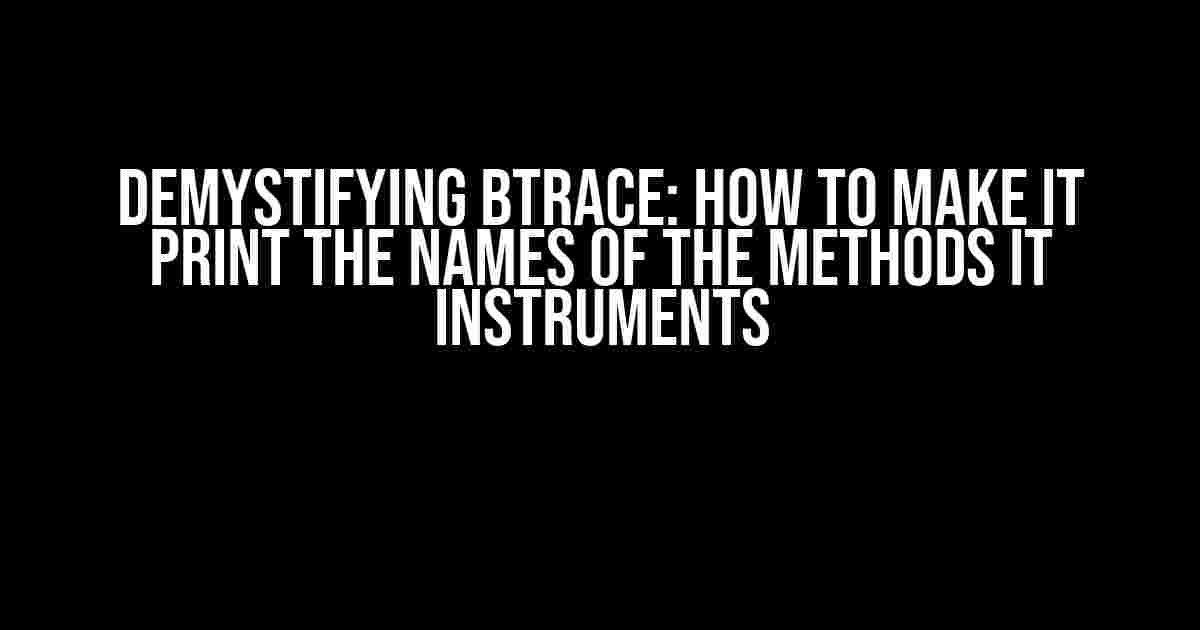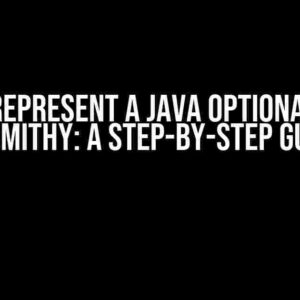Are you tired of wondering which methods BTrace is actually instrumenting? Do you want to unlock the full potential of this powerful Java profiling tool? Look no further! In this article, we’ll dive deep into the world of BTrace and explore how to make it print the names of the methods it instruments.
What is BTrace?
Before we dive into the nitty-gritty, let’s take a step back and understand what BTrace is. BTrace is a Java-based profiling tool that allows developers to dynamically instrument and monitor their applications. It’s like having a pair of X-ray glasses that let you see what’s going on under the hood of your Java application.
Why Do I Need to Know Which Methods BTrace Instruments?
Knowing which methods BTrace instruments is crucial for several reasons:
- Accurate Profiling**: By knowing which methods are being instrumented, you can focus on optimizing the most critical parts of your application.
- Reducing Overhead**: Instrumenting unnecessary methods can lead to performance overhead. By knowing which methods are being instrumented, you can avoid unnecessary instrumentation.
- Improved Debugging**: Understanding which methods are being instrumented can help you identify issues and debug your application more effectively.
The Magic of -printmethods
The secret to making BTrace print the names of the methods it instruments lies in the -printmethods option. This option is a part of BTrace’s command-line interface and can be used to print the names of the methods that are being instrumented.
$ btrace -printmethods -cp /path/to/your/classpath your.profiler.Script
In this example, we’re using the -printmethods option to tell BTrace to print the names of the methods it instruments. The -cp option specifies the classpath, and your.profiler.Script is the name of your BTrace script.
A Beginner’s Guide to Using -printmethods
If you’re new to BTrace, don’t worry! Using the -printmethods option is relatively straightforward. Here’s a step-by-step guide to get you started:
- Write Your BTrace Script**: Create a BTrace script that defines the methods you want to instrument. For example:
import org.btrace.annotations.*;@BTrace public class PrintMethods {
@OnMethod(clazz = "your.package.YourClass", method = "yourMethod")
public static void printMethod(@ProbeClassName STRINGprobeClass,
@ProbeMethodName STRINGprobeMethod) {
println(probeClass + "." + probeMethod);
}
}
- Compile Your Script**: Compile your BTrace script into a .class file using the BTrace compiler.
- Run BTrace with -printmethods**: Run BTrace with the -printmethods option, specifying your script and classpath.
Understanding the Output
When you run BTrace with the -printmethods option, you’ll see an output that looks something like this:
Classloader: [sun.misc.Launcher$AppClassLoader@14dad5dc] Method: your.package.YourClass.yourMethod ProbeClass: your.package.YourClass ProbeMethod: yourMethod ...
This output tells you which methods are being instrumented, along with the classloader and probe class/method information.
Decoding the Output
Let’s break down the output to understand what each part means:
| Component | Description |
|---|---|
| Classloader | The classloader responsible for loading the instrumented class. |
| Method | The fully qualified name of the instrumented method. |
| ProbeClass | The class that contains the instrumented method. |
| ProbeMethod | The name of the instrumented method. |
Common Pitfalls and Troubleshooting
While using the -printmethods option is relatively straightforward, there are some common pitfalls to watch out for:
- Method Not Found**: If BTrace can’t find the method you’re trying to instrument, it won’t print anything. Double-check your script and classpath to ensure everything is correct.
- Invalid Classpath**: Make sure your classpath is correct and includes all the necessary classes.
- Script Errors**: If your script contains errors, BTrace won’t be able to instrument the methods correctly. Check your script for syntax errors and logical mistakes.
Conclusion
And there you have it! With the -printmethods option, you can now see which methods BTrace is instrumenting. By following the steps outlined in this article, you’ll be well on your way to unlocking the full potential of BTrace.
Remember, understanding which methods are being instrumented is crucial for accurate profiling, reducing overhead, and improving debugging. With this knowledge, you’ll be able to optimize your application like a pro!
Happy profiling!
Frequently Asked Question
Get the inside scoop on how to make BTrace print the names of the methods it actually instruments!
Q: What is the magic flag to make BTrace print method names?
Ah-ha! You’re looking for the `-Dcom.sun.btrace.dumpClassesAndMethods=true` flag! This magic flag will instruct BTrace to print the names of the methods it instruments. Just add it to your BTrace command, and voilà!
Q: Where do I add the flag? Is it in the BTrace script or the command line?
You can add the flag either in the BTrace script or on the command line. If you’re using a script, simply add the flag as an argument to the `btrace` command. If you’re running BTrace from the command line, add the flag before the script name. For example: `java -Dcom.sun.btrace.dumpClassesAndMethods=true -jar btrace.jar yourScript.btrace`
Q: Will this flag print all method names or just the ones that are actually instrumented?
With the `-Dcom.sun.btrace.dumpClassesAndMethods=true` flag, BTrace will print the names of all classes and methods it encounters, not just the ones that are actually instrumented. If you want to see only the instrumented methods, you can use the `-Dcom.sun.btrace.dumpInstrumentedMethods=true` flag instead!
Q: Can I use these flags together or are they mutually exclusive?
You can use both flags together! In fact, using `-Dcom.sun.btrace.dumpClassesAndMethods=true` and `-Dcom.sun.btrace.dumpInstrumentedMethods=true` will give you a comprehensive view of what BTrace is doing under the hood. Go ahead and combine them for maximum visibility!
Q: Are there any performance implications when using these flags?
While these flags can provide valuable insights, they can impact performance. BTrace will spend more time dumping class and method information, which can slow down your application. Use these flags judiciously, especially in production environments, and consider disabling them once you’ve gathered the information you need.


